
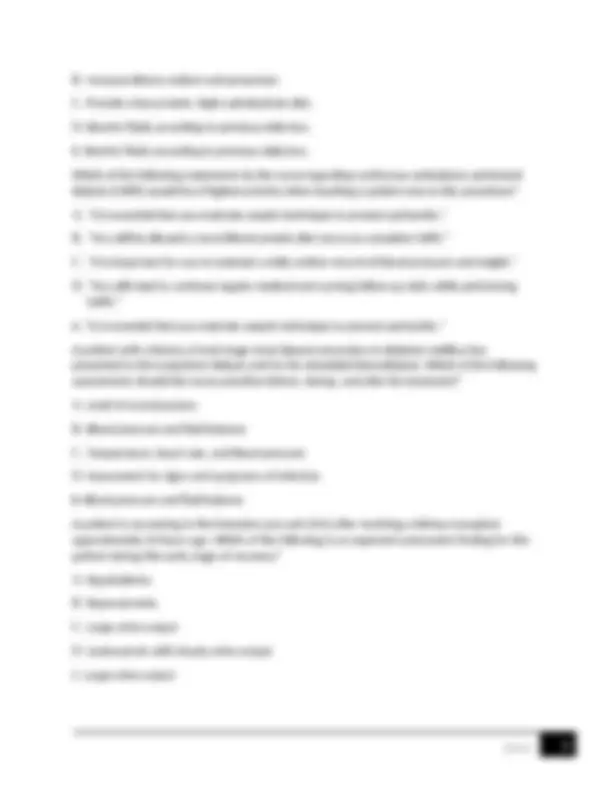
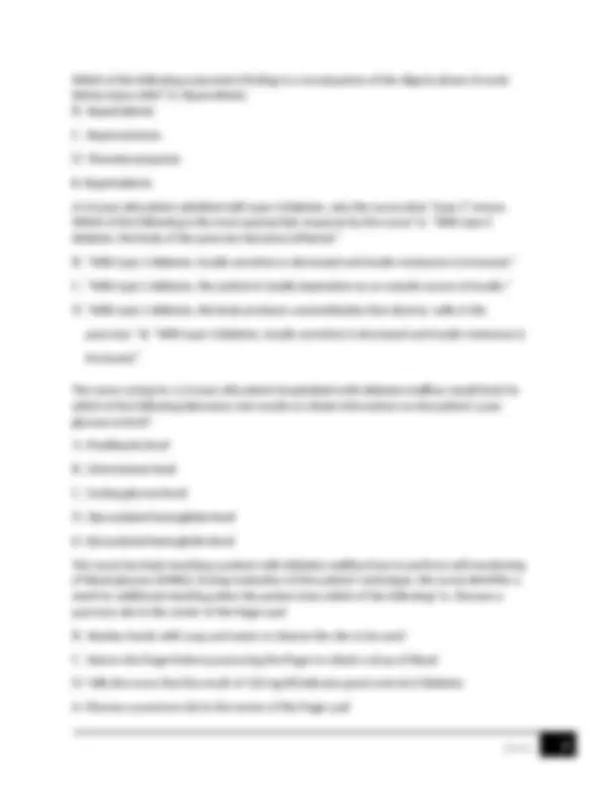

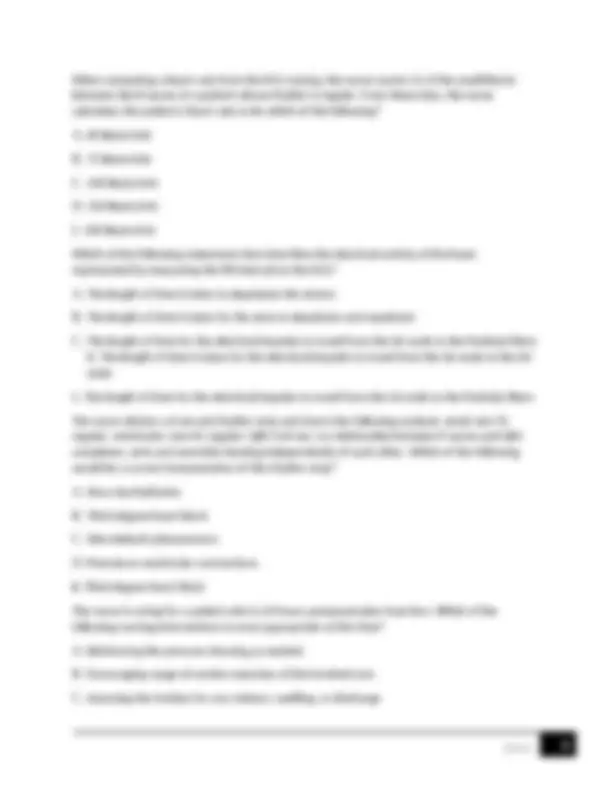
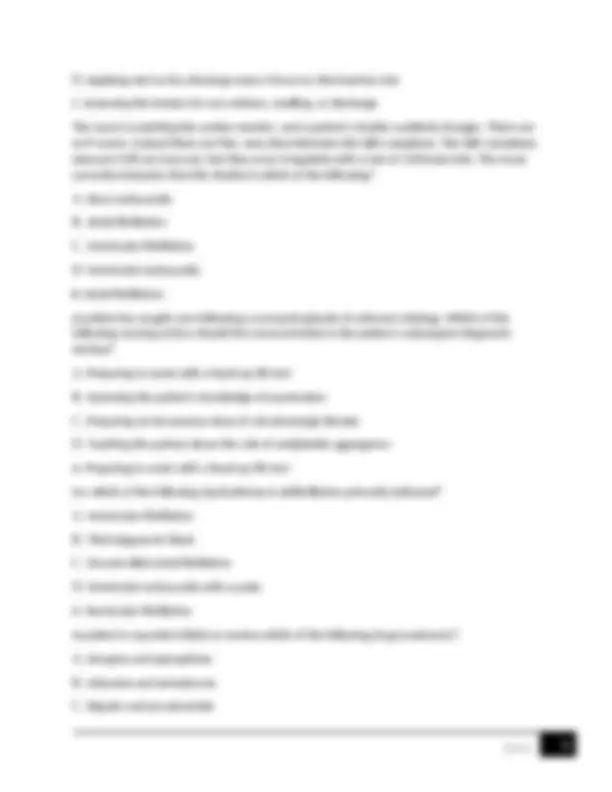
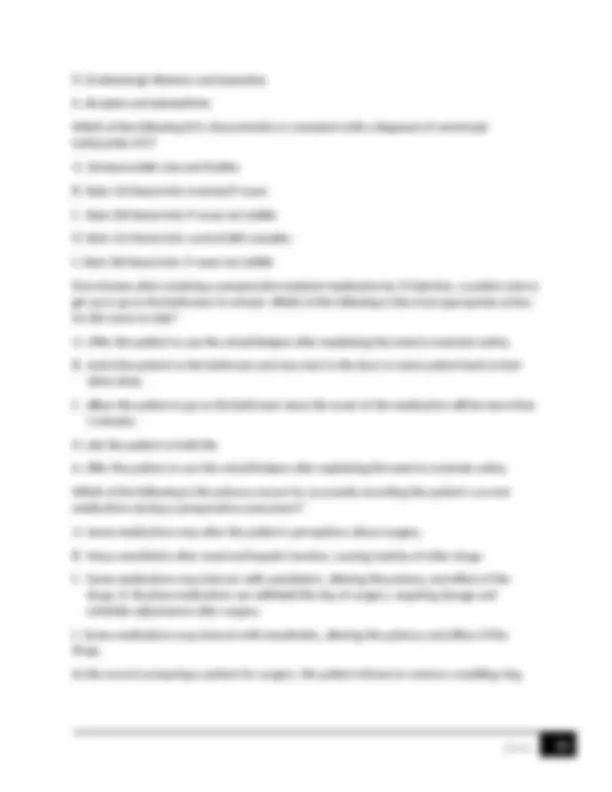
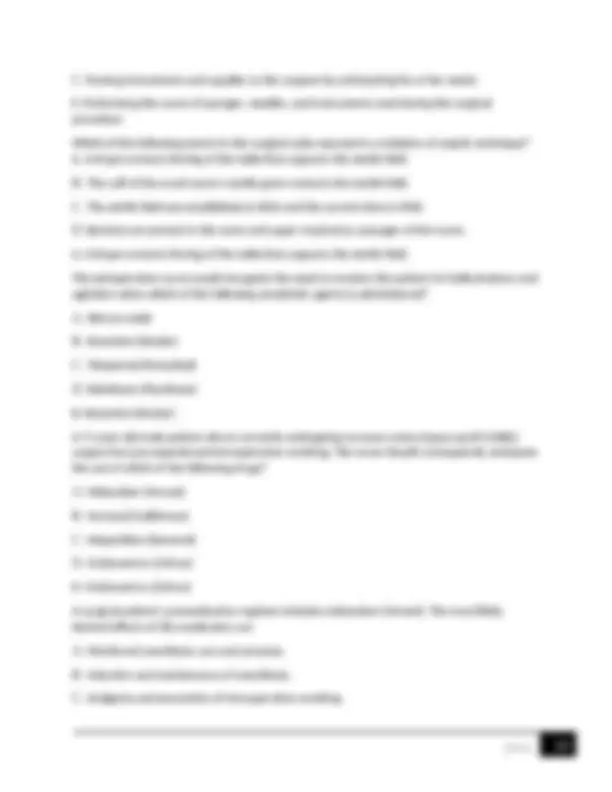

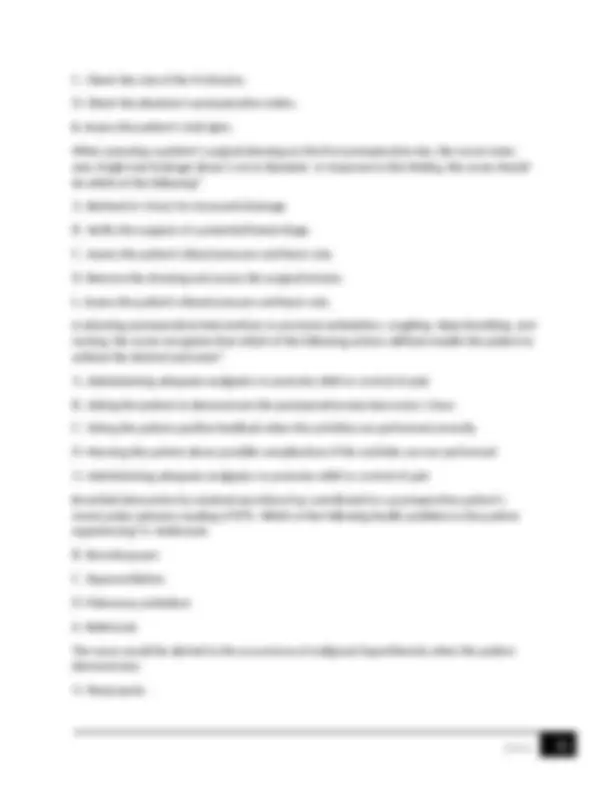


Study with the several resources on Docsity

Earn points by helping other students or get them with a premium plan


Prepare for your exams
Study with the several resources on Docsity

Earn points to download
Earn points by helping other students or get them with a premium plan
Community
Ask the community for help and clear up your study doubts
Discover the best universities in your country according to Docsity users
Free resources
Download our free guides on studying techniques, anxiety management strategies, and thesis advice from Docsity tutors
MEDSURG FINAL EXAM PRACTICE QUESTIONS WITH CORRECT ANSWERS The nurse is admitting a patient with the diagnosis of advanced renal carcinoma. Based upon this diagnosis, the nurse will expect to find which of the following as the "classic triad" of presenting symptoms occurring in patients with renal cancer? A. Fever, chills, flank pain B. Hematuria, flank pain, palpable mass C. Hematuria, proteinuria, palpable mass D. Flank pain, palpable abdominal mass, and proteinuria B. Hematuria, flank pain, palpable mass
Typology: Exams
1 / 16

This page cannot be seen from the preview
Don't miss anything!










The nurse is admitting a patient with the diagnosis of advanced renal carcinoma. Based upon this diagnosis, the nurse will expect to find which of the following as the "classic triad" of presenting symptoms occurring in patients with renal cancer? A. Fever, chills, flank pain B. Hematuria, flank pain, palpable mass C. Hematuria, proteinuria, palpable mass D. Flank pain, palpable abdominal mass, and proteinuria B. Hematuria, flank pain, palpable mass Which of the following nursing interventions is appropriate in providing care for an adult patient with newly diagnosed adult onset polycystic kidney disease (PKD)? A. Help the patient cope with the rapid progression of the disease. B. Suggest genetic counseling resources for the children of the patient. C. Expect the patient to have polyuria and poor concentration ability of the kidneys. D. Implement appropriate measures for the patient's deafness and blindness in addition to the renal problems. B. Suggest genetic counseling resources for the children of the patient. An elderly male patient visits his primary care provider because of burning on urination and production of urine that he describes as "foul smelling." The health care provider should assess the patient for which of the following factors that may dispose him to urinary tract infections (UTIs)? A. High-purine diet B. Sedentary lifestyle C. Benign prostatic hyperplasia (BPH) D. Recent use of broad-spectrum antibiotics C. Benign prostatic hyperplasia (BPH) The nurse is providing care for a patient who has been admitted to the hospital for the treatment of nephrotic syndrome. Which of the following is a priority nursing assessment in the care of this patient?
A. Assessment of pain and level of consciousness B. Assessment of serum calcium and phosphorus levels C. Blood pressure and assessment for orthostatic hypotension D. Daily weights and measurement of the patient's abdominal girth D. Daily weights and measurement of the patient's abdominal girth Which of the following nursing diagnoses is a priority in the care of a patient with renal calculi? A. Acute pain B. Deficient fluid volume C. Risk for constipation D. Risk for powerlessness A. Acute pain Eight months after the delivery of her first child, a 31-year-old woman has sought care because of occasional incontinence that she experiences when sneezing or laughing. Which of the following measures should the nurse first recommend in an attempt to resolve the woman's incontinence? A. Kegel exercises B. Use of adult incontinence pads C. Intermittent self-catheterization D. Dietary changes including fluid restriction A. Kegel exercise The nurse preparing to administer a dose of PhosLo to a patient with chronic kidney disease would interpret that this medication should have a beneficial effect on which of the following laboratory values of the patient? A. Sodium B. Potassium C. Magnesium D. Phosphorus D. Phosphorus When caring for a patient during the oliguric phase of acute kidney injury, which of the following would be an appropriate nursing intervention? A. Weigh patient three times weekly.
Which of the following assessment findings is a consequence of the oliguric phase of acute kidney injury (AKI)? A. Hypovolemia B. Hyperkalemia C. Hypernatremia D. Thrombocytopenia B. Hyperkalemia A 54-year-old patient admitted with type 2 diabetes, asks the nurse what "type 2" means. Which of the following is the most appropriate response by the nurse? A. "With type 2 diabetes, the body of the pancreas becomes inflamed." B. "With type 2 diabetes, insulin secretion is decreased and insulin resistance is increased." C. "With type 2 diabetes, the patient is totally dependent on an outside source of insulin." D. "With type 2 diabetes, the body produces autoantibodies that destroy -cells in the pancreas." B. "With type 2 diabetes, insulin secretion is decreased and insulin resistance is increased." The nurse caring for a 54-year-old patient hospitalized with diabetes mellitus would look for which of the following laboratory test results to obtain information on the patient's past glucose control? A. Prealbumin level B. Urine ketone level C. Fasting glucose level D. Glycosylated hemoglobin level D. Glycosylated hemoglobin level The nurse has been teaching a patient with diabetes mellitus how to perform self-monitoring of blood glucose (SMBG). During evaluation of the patient's technique, the nurse identifies a need for additional teaching when the patient does which of the following? A. Chooses a puncture site in the center of the finger pad B. Washes hands with soap and water to cleanse the site to be used C. Warms the finger before puncturing the finger to obtain a drop of blood D. Tells the nurse that the result of 120 mg/dl indicates good control of diabetes A. Chooses a puncture site in the center of the finger pad
The nurse is teaching a 54-year-old patient with diabetes about proper composition of the daily diet. The nurse explains that the guideline for carbohydrate intake is which of the following? A. 80% of daily intake B. Minimum of 80 g/day C. Minimum of 130 g/day D. Maximum of 130 g/day C. Minimum of 130 g/day The nurse is assigned to the care of a 64-year-old patient diagnosed with type 2 diabetes. In formulating a teaching plan that encourages the patient to actively participate in management of the diabetes, which of the following should be the nurse's initial intervention? A. Assess patient's perception of what it means to have diabetes. B. Ask the patient to write down current knowledge about diabetes. C. Set goals for the patient to actively participate in managing his diabetes. D. Assume responsibility for all of the patient's care to decrease stress level. A. Assess patient's perception of what it means to have diabetes. The nurse is beginning to teach a diabetic patient about vascular complications of diabetes. Which of the following information would be appropriate for the nurse to include? A. Macroangiopathy does not occur in type 1 diabetes but rather in type 2 diabetics who have severe disease. B. Microangiopathy is specific to diabetes and most commonly affects the capillary membranes of the eyes, kidneys, and skin. C. Renal damage resulting from changes in large- and medium-sized blood vessels can be prevented by careful glucose control. D. Macroangiopathy causes slowed gastric emptying and the sexual impotency experienced by a majority of patients with diabetes. B. Microangiopathy is specific to diabetes and most commonly affects the capillary membranes of the eyes, kidneys, and skin. The nurse is evaluating a 45-year-old patient diagnosed with type 2 diabetes mellitus. Which of the following symptoms reported by the patient is considered one of the classic clinical manifestations of diabetes? A. Excessive thirst B. Gradual weight gain
B. Decreased low-density lipoproteins C. Increased high-density lipoproteins D. Decreased very-low-density lipoproteins A. Increased triglyceride levels The nurse has taught a patient admitted with diabetes, cellulitis, and osteomyelitis about the principles of foot care. The nurse evaluates that the patient understands the principles of foot care if the patient makes which of the following statements? A. "I should only walk barefoot in nice dry weather." B. "I should look at the condition of my feet every day." C. "I am lucky my shoes fit so nice and tight because they give me firm support." D. "When I am allowed up out of bed, I should check the shower water with my toes." B. "I should look at the condition of my feet every day." A patient is admitted with diabetes mellitus, malnutrition, and cellulitis. The patient's potassium level is 5.6 mEq/L. The nurse considers that which of the following could be a contributing factor for this lab result (select all that apply)? A. The level may be increased as a result of dehydration that accompanies hyperglycemia. B. The patient may be excreting extra sodium and retaining potassium because of malnutrition. C. The level is consistent with renal insufficiency that can develop with renal nephropathy. D. tThe level may be raised as a result of metabolic ketoacidosis caused by hyperglycemia. A. The level may be increased as a result of dehydration that accompanies hyperglycemia. C. The level is consistent with renal insufficiency that can develop with renal nephropathy. D. The level may be raised as a result of metabolic ketoacidosis caused by hyperglycemia. The patient received regular insulin 10 units subcutaneously at 8:30 pm for a blood glucose level of 253 mg/dl. The nurse plans to monitor this patient for signs of hypoglycemia at which of the following peak action times? A. 9:00 pm to 10:30 pm B. 10:30 pm to 11:30 pm C. 12:30 am to 1:30 am D. 2:30 am to 4:30 am B. 10:30 pm to 11:30 pm
When computing a heart rate from the ECG tracing, the nurse counts 15 of the small blocks between the R waves of a patient whose rhythm is regular. From these data, the nurse calculates the patient's heart rate to be which of the following? A. 60 Beats/min B. 75 Beats/min C. 100 Beats/min D. 150 Beats/min C. 100 Beats/min Which of the following statements best describes the electrical activity of the heart represented by measuring the PR interval on the ECG? A. The length of time it takes to depolarize the atrium B. The length of time it takes for the atria to depolarize and repolarize C. The length of time for the electrical impulse to travel from the SA node to the Purkinje fibers D. The length of time it takes for the electrical impulse to travel from the SA node to the AV node C. The length of time for the electrical impulse to travel from the SA node to the Purkinje fibers The nurse obtains a 6-second rhythm strip and charts the following analysis: atrial rate 70, regular; ventricular rate 40, regular; QRS 0.04 sec; no relationship between P waves and QRS complexes; atria and ventricles beating independently of each other. Which of the following would be a correct interpretation of this rhythm strip? A. Sinus dysrhythmias B. Third-degree heart block C. Wenckebach phenomenon D. Premature ventricular contractions B. Third-degree heart block The nurse is caring for a patient who is 24 hours postpacemaker insertion. Which of the following nursing interventions is most appropriate at this time? A. Reinforcing the pressure dressing as needed B. Encouraging range-of-motion exercises of the involved arm C. Assessing the incision for any redness, swelling, or discharge
D. β-Adrenergic blockers and dopamine A. Atropine and epinephrine Which of the following ECG characteristics is consistent with a diagnosis of ventricular tachycardia (VT)? A. Unmeasurable rate and rhythm B. Rate 150 beats/min; inverted P wave C. Rate 200 beats/min; P wave not visible D. Rate 125 beats/min; normal QRS complex C. Rate 200 beats/min; P wave not visible Five minutes after receiving a preoperative sedative medication by IV injection, a patient asks to get up to go to the bathroom to urinate. Which of the following is the most appropriate action for the nurse to take? A. Offer the patient to use the urinal/bedpan after explaining the need to maintain safety. B. Assist the patient to the bathroom and stay next to the door to assist patient back to bed when done. C. Allow the patient to go to the bathroom since the onset of the medication will be more than 5 minutes. D. Ask the patient to hold the A. Offer the patient to use the urinal/bedpan after explaining the need to maintain safety. Which of the following is the primary reason for accurately recording the patient's current medications during a preoperative assessment? A. Some medications may alter the patient's perceptions about surgery. B. Many anesthetics alter renal and hepatic function, causing toxicity of other drugs. C. Some medications may interact with anesthetics, altering the potency and effect of the drugs. D. Routine medications are withheld the day of surgery, requiring dosage and schedule adjustments after surgery. C. Some medications may interact with anesthetics, altering the potency and effect of the drugs. As the nurse is preparing a patient for surgery, the patient refuses to remove a wedding ring.
Which of the following is the most appropriate action by the nurse? A. Insist the patient remove the ring for safety purposes. B. Explain that the hospital will not be responsible for the ring. C. Tape the ring securely to the finger and document this on the preoperative checklist. D. Note the presence of the ring in the nurse's notes of the chart and on the preoperative checklist. C. Tape the ring securely to the finger and document this on the preoperative checklist. While performing preoperative teaching, the patient asks when she needs to stop drinking water before the surgery. Based on the most recent practice guidelines established by the American Society of Anesthesiologists, the nurse tells the patient that A. She must be NPO after breakfast. B. She needs to be NPO after midnight. C. She can drink clear liquids up to 2 hours before surgery. D. She can drink clear liquids up until she is moved to the OR. C. She can drink clear liquids up to 2 hours before surgery. The nurse is admitting a patient to the same-day surgery unit. The patient tells the nurse that he was so nervous he had to take kava last evening to help him sleep. Which of the following nursing actions would be most appropriate? A. Tell the patient that using kava to help sleep is often helpful. B. Inform the anesthesiologist of the patient's recent use of kava. C. Tell the patient that the kava should continue to help him relax before surgery. D. Inform the patient about the dangers of taking herbal medicines without consulting his health care provider. B. Inform the anesthesiologist of the patient's recent use of kava. Which of the following preoperative patients likely faces the greatest risk of bleeding as a result of their medication? A. A woman who takes metoprolol (Lopressor) for the treatment of hypertension B. A man whose type 1 diabetes is controlled with insulin injections four times daily C. A man who is taking clopidogrel (Plavix) after the placement of a coronary artery stent D. A man who recently started taking finasteride (Proscar) for the treatment of benign prostatic hyperplasia
C. Passing instruments and supplies to the surgeon by anticipating his or her needs E. Performing the count of sponges, needles, and instruments used during the surgical procedure Which of the following events in the surgical suite represents a violation of aseptic technique? A. A drape contacts the leg of the table that supports the sterile field. B. The cuff of the scrub nurse's sterile gown contacts the sterile field. C. The sterile field was established at 0650 and the current time is 0900. D. Bacteria are present in the nares and upper respiratory passages of the nurse. A. A drape contacts the leg of the table that supports the sterile field. The perioperative nurse would recognize the need to monitor the patient for hallucinations and agitation when which of the following anesthetic agents is administered? A. Nitrous oxide B. Ketamine (Ketalar) C. Thiopental (Pentathal) D. Halothane (Fluothane) B. Ketamine (Ketalar) A 71-year-old male patient who is currently undergoing coronary artery bypass graft (CABG) surgery has just experienced intraoperative vomiting. The nurse should consequently anticipate the use of which of the following drugs? A. Midazolam (Versed) B. Fentanyl (Sublimaze) C. Meperidine (Demerol) D. Ondansetron (Zofran) D. Ondansetron (Zofran) A surgical patient's premedication regimen includes midazolam (Versed). The most likely desired effects of this medication are A. Monitored anesthesia care and amnesia. B. Induction and maintenance of anesthesia. C. Analgesia and prevention of intraoperative vomiting.
D. Relaxation of skeletal muscles and facilitation of endotracheal intubation. A. Monitored anesthesia care and amnesia. Unless contraindicated by the surgical procedure, which of the following positions is preferred for the unconscious patient immediately postoperative? A. Supine B. Lateral C. Semi-Fowler's D. High-Fowler's B. Lateral A postoperative patient is transferred from the postanesthesia unit to the medical-surgical nursing floor. The nurse notes that the patient has an order for D5½ NS to infuse at 125 ml/hr. Until an IV pump is available, the nurse regulates the IV flow rate at which of the following drops (gtts)/min, noting that the tubing has a drop factor of 10 drops/ml? A. 13 gtts/min B. 31 gtts/min C. 25 gtts/min D. 21 gtts/min D. 21 gtts/min The nurse is preparing to administer cefazolin (Ancef) 2 gm in 100 ml of normal saline to a postoperative patient. Which of the following IV rates will infuse this medication over 20 minutes? A. 100 ml/hr B. 150 ml/hr C. 200 ml/hr D. 300 ml/hr D. 300 ml/hr The nurse is working on a surgical floor and is preparing to receive a postoperative patient from the postanesthesia unit. Which of the following should be the nurse's initial action upon the patient's arrival? A. Assess the patient's pain. B. Assess the patient's vital signs.
B. Muscle rigidity. C. Decreased body temperature. D. Confusion upon arousal from anesthesia.